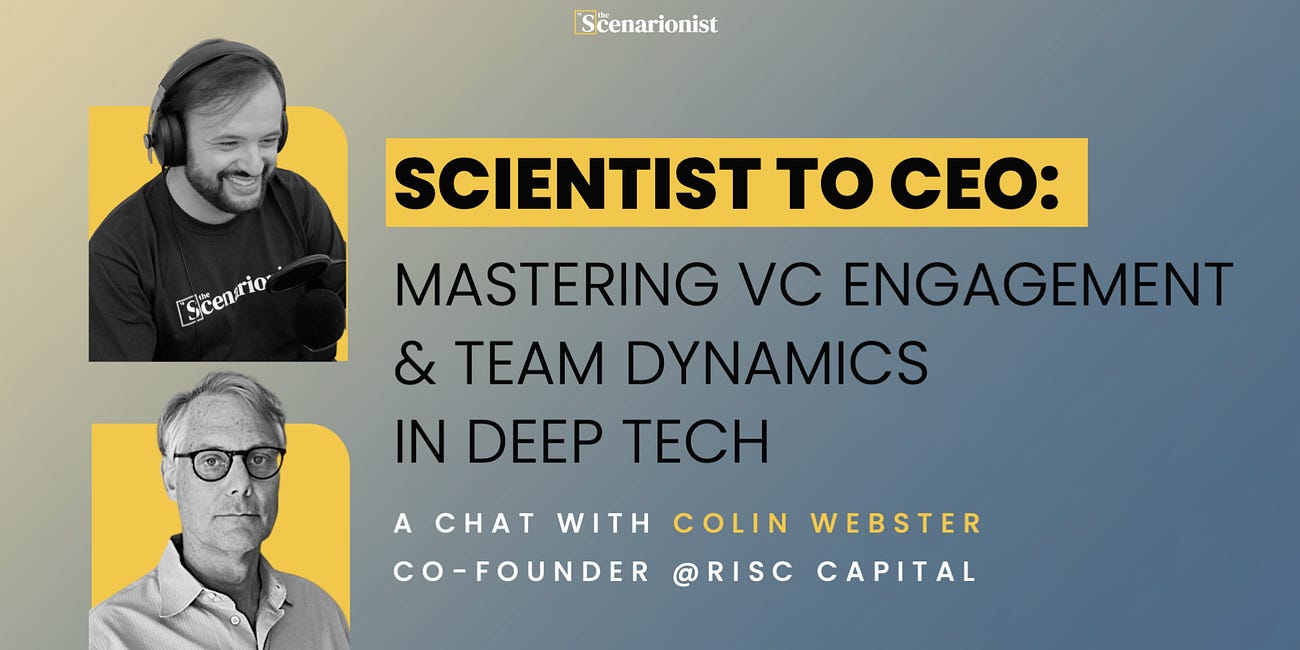Welcome back to Deep Tech Catalyst, where we spotlight the pathways, challenges, and critical strategies in building successful Deep Tech startups!
In this chat, we dive deep into the complexities and strategic decisions needed to turn a groundbreaking idea into a successful scalable venture with DC Palter, founder with multiple exits, Angel investor, Mentor Lead at the Chemical Angel Network, and Executive Committee member at Tech Coast Angels.
We’ll tackle key themes such as the differences between developing software and hardware products, understanding investor perspectives on scalability, and the unique challenges entrepreneurs face on their growth journey.
This episode is a must-listen for aspiring scientific founders in the Deep Tech space.
Let’s get started!
🎧 Prefer to listen?
🏭 Producing a Deep Tech Product Means Building a Factory
Embarking on a hardware startup journey is a multifaceted challenge. Entrepreneurs must bridge the gap between a scientific concept and a commercially viable product. This journey involves not only mastering production processes but also grappling with the logistics of supply chains, the demands of capital-intensive setups, and the strategic planning required for market entry and growth.
It’s a path that requires more than just technical expertise – it calls for a holistic approach to business, blending science, manufacturing acumen, and strategic market insight.
🤼 Software vs. Hardware
While software development requires coding skills and a computer, leading to quick deployment and low initial costs, hardware ventures into a more intricate territory.
Building a hardware product, like a new component for a battery, involves a tangible creation process, demanding substantial resources, manufacturing facilities, and labor.
This difference fundamentally alters the journey a startup must embark on.
The Investor's Lens: Assessing Potential Beyond the Idea
For investors, the decision to fund a startup transcends the allure of groundbreaking science or innovative ideas. Their focus lies in the company's ability to not just conceive but also produce and sell a product.
In evaluating hardware startups, investors scrutinize the practicality of bringing the product to market, its scalability, and the company's overall potential for growth.
The inherent risks in hardware production, due to substantial initial investments and operational complexities, make this a crucial aspect of their assessment.
Scalability: A Key Differentiator in Startup Success
Scalability is the lifeline of any startup, but its meaning varies starkly between software and hardware domains. Here’s how:
In software, scalability is often a matter of upgrading the system and ensuring server capacity.
For hardware, it’s a more elaborate venture involving expanding physical production capabilities, navigating logistical challenges, and ensuring consistent supply chain efficiency.
This difference underpins the varied paths startups in these sectors must navigate for growth.
The Backbone of Hardware Production: The Supply Chain
In the hardware industry, a robust and dependable supply chain serves as more than just an operational requirement; it serves as the very foundation of the entire production process.
The ability to consistently manufacture and deliver products hinges on the resilience and effectiveness of the supply chain. For entrepreneurs, establishing and sustaining this supply chain represents a critical, albeit challenging, aspect of their business. This directly influences their capacity to meet market demands and expand their operations.
Unlike software, where rapid iteration and pivoting are feasible, hard tech startups face a lengthy journey from initial lab testing to pilot-scale production before achieving full-scale manufacturing.
This journey demands increasing capital and presents a range of challenges, including supply chain management, quality control in production, equipment procurement, workforce recruitment, and addressing potential returns.
In essence, the company's primary focus shifts from scientific innovation to the intricacies of operational management, a transition that can be both daunting and intricate.
🤔 Licensing or Product Production?
In the startup world, entrepreneurs often grapple with a crucial decision: whether to manufacture their product or opt for licensing to a third party.
Manufacturing a product entails establishing and managing the entire production and distribution process, a task that can be both capital-intensive and intricate. On the other hand, licensing involves granting another company the right to produce and market the product in exchange for royalty payments. This approach can be less resource-intensive for the original inventors since it shifts the responsibility for production, marketing, and distribution to the licensee.
Royalty Percentages in Licensing Deals
Licensing agreements typically involve royalty percentages, which can vary widely depending on factors like industry, product uniqueness, and market potential.
Generally, licensing deals yield royalties that amount to approximately 2% to 3% of the licensee's revenue. For products that are less critical or less unique, these rates can drop as low as 0.1%.
It's essential to remember that these figures are rough estimates, and real-world deals can exhibit significant variations.
Acquisition Perspectives
The dynamics of acquisition differ significantly between licensing and in-house production. In the case of licensing, the original company's revenue is primarily limited to the royalty stream, typically a modest percentage of total sales. Consequently, this can make the company less appealing for a large-scale acquisition, as potential buyers may prefer to license the technology instead of acquiring the entire company. In contrast, a company that manufactures and sells its product retains a more substantial portion of the revenue, potentially making it a more attractive acquisition candidate.
Venture Capitalists' Perspective
For Venture Capitalists (VCs), achieving a substantial return on investment is paramount.
Licensing agreements, while providing a steady revenue stream, often fall short of delivering the high returns VCs aim for.
VCs typically seek exponential growth in a company's value before considering acquisition or going public. The limited revenue potential associated with licensing deals frequently fails to meet these high-return thresholds. In contrast, manufacturing a product in-house and scaling the company can yield the type of returns that align with VC investment objectives.
In Summary
In summary, the choice between licensing and in-house production carries significant ramifications for a company's growth trajectory, appeal to investors, and potential for acquisition. Licensing provides a less capital-intensive path with consistent but limited returns. Conversely, internal production can lead to higher revenues and a potentially more appealing acquisition profile, better aligning with the high-return expectations of Venture Capitalists.
While licensing remains a viable business model, it may not align with the traditional venture capital model. Venture capitalists seek startups that can rapidly scale and generate substantial returns upon acquisition, a criterion that licensing typically doesn't meet.
Therefore, if your goal is to attain unicorn status and attract venture capital, be prepared to embrace the challenges of production.
📈 Navigating Investor Expectations for Scientific Startups
In the realm of scientific innovation, the journey from a laboratory breakthrough to a successful startup is intricate. The initial excitement surrounding scientific discovery, particularly one that's patented and accompanied by a promising prototype, often leads scientists to approach investors. However, a common misstep at this stage is the overemphasis on the science itself. Investors, are primarily interested in profitability, so the scientific founder must align with their goals.
3 Key points to stress while approaching an investor in Deep Tech:
Invention's Utility: The first critical step for scientific founders is to establish the utility of their invention. This is just the beginning, a third of the journey. It's essential to demonstrate that the invention solves a significant problem and holds practical value.
Business Viability: The next phase is proving the business potential of the invention. Founders must articulate how their idea will evolve into a business with substantial revenue. This involves considering aspects like manufacturing, market competition, team building, and overall strategy.
Investment Attractiveness: Finally, the focus shifts to the attractiveness of the venture as an investment. This stage involves convincing investors of the potential financial returns. It's about painting a picture of the startup's journey to becoming a highly profitable enterprise.
Pricing, Market, and Customers
In the early stages, when customer traction and revenue are still in their infancy, investors require comprehensive information. They seek to understand the startup's approach to pricing, industry partnerships, and customer acquisition. The go-to-market strategy is often more crucial than the product itself.
Founders need to convey a well-considered plan detailing:
Pricing Strategy: How will the product be priced? What structure will be used to determine pricing?
Market Approach: Is the target market narrow with a handful of potential customers, or broad, requiring significant advertising and sales efforts?
Customer Engagement: How will the startup engage with potential customers? Will it involve direct sales, distributors, or other channels?
The early-stage investors need to see a plan, even if it's not pinpoint accurate. They look for an outline that demonstrates a clear path to scaling up and achieving a substantial market presence.
🧠 Food for thoughts: Research Project vs Investable Company
An investable company transcends the boundaries of a mere research project. Investors need to see that the founders have thoroughly contemplated how to sell their product in the market. This involves not just identifying a market need but also devising a feasible and effective strategy for market penetration and customer engagement.
🧟 A Brief Focus on “The Valley of Death” in Early-Stage Deep Tech
The "valley of death" in the context of startups, particularly in Deep Tech, refers to the critical phase where a venture moves from a promising concept or prototype to a commercially viable product. This phase is fraught with challenges like securing funding, achieving market fit, and scaling operations, often leading to a high failure rate.
Exit Prospects
Deep Tech includes IPOs or acquisitions, but these are rarer and often at lower valuations compared to software. Exit prospects in Deep Tech vary by sector, for instance:
Life Sciences: Potential for high-value acquisitions by large pharmaceutical companies.
The Life Sciences sector, which includes pharmaceuticals and biotechnology, has a different investment appeal. Despite the high costs of development and regulatory hurdles, the potential for significant returns upon successful drug development and approval makes it an attractive field. Acquisitions by larger pharmaceutical companies can be lucrative, promising high returns to early investors.
Chemical/ Advanced Materials: More modest acquisitions, usually as additions to existing portfolios of larger companies.
In the chemical and advanced materials sector, startups often face challenges in scaling production and achieving market penetration. The acquisitions in this sector are usually not as high-value as in software or life sciences, often based on smaller multiples of profits. This can limit the appeal to venture capitalists looking for high-return exits.
Impact of the Climate Crisis on Investment Trends
The growing concern for the climate crisis has significantly influenced investment trends. There's an increasing flow of capital into technologies that address environmental challenges. This shift is creating new opportunities for Deep Tech startups in areas like renewable energy, battery technology, and sustainable materials. While exits in these areas are still evolving, the societal and governmental push towards sustainable solutions is likely to enhance their value and attractiveness to investors.
Take Home Messages for Scientist Entrepreneurs
Pursue Non-Dilutive Funding: Seek out grants, fellowships, and government programs to fund early-stage research and development without giving up equity.
Build Strategic Partnerships: Collaborate with universities, research institutions, and industry partners to gain access to resources, expertise, and networks.
Focus on Milestones: Prioritize development goals that lead to proof of concept, prototypes, or early customer validation to attract further investment.
Engage with Specialized Investors: Target investors who understand and specialize in Deep Tech and are familiar with its challenges and timelines.
Leverage Accelerators and Incubators: Participate in programs specifically designed for Deep Tech startups, which offer mentorship, funding, and networking opportunities.
In Conclusion
In summary, scientific founders must understand that while their scientific discovery is the seed of their venture, the growth and success of the startup depend on their ability to articulate its business potential, scalability, and profitability to investors. The transition from an innovative idea to an investable company requires meticulous planning, a solid business strategy, and an acute awareness of investor expectations.
This is all for today! 👋
Wanna be more involved?
👉🏻 Follow our LinkedIn page and drop a DM!
👉🏻 Write us a line here: info@thescenarionist.org























